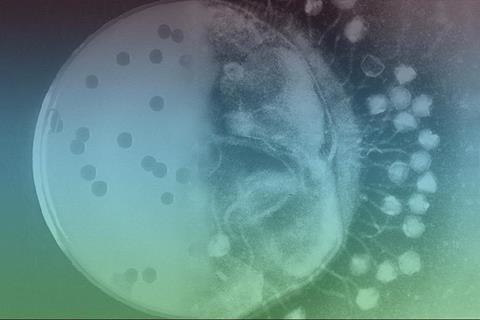A novel bacteriophage isolated from sewage water not only kills its target bacteria in the Klebsiella oxytoca complex but was unexpectedly found to be capable of disrupting biofilms produced by these bacteria.
The research, by a team at Nottingham Trent Univerisity, is outlined in the paper ‘Lytic bacteriophage vB_KmiS-Kmi2C disrupts biofilms formed by members of the Klebsiella oxytoca complex, and represents a novel virus family and genus’ in the Journal of Applied Microbiology, an Applied Microbiology International publication.

The phage was originally isolated by Dr Preetha Shibu while she was working towards her Professional Doctorate, under the guidance of Dr Anne McCartney and Professor Lesley Hoyles, and was found to kill a multidrug-resistant strain of Klebsiella michiganensis, of the Klebsiella oxytoca complex.
“Antimicrobial resistance is increasingly seen in clinical strains belonging to the K. oxytoca complex, an emerging group of pathogens,” said corresponding author Professor Lesley Hoyles.
Treatment failures
“Biofilms formed by these bacteria - especially on medical devices or wounds - also contribute to treatment failures, by preventing antibiotics getting to where they are needed.
“Bacteriophages can be used as an alternative to antimicrobial therapies, as they kill bacteria in a strain- to species-selective manner.
“The work included in our publication is part of ongoing efforts to build a collection of bacteriophages that target members of the K. oxytoca complex. Discovery of a bacteriophage that could prevent biofilm formation and disrupt established biofilms was an unexpected bonus!”
Professor Hoyles stressed that this was very much a team effort, combining the interests of many researchers over several years.
Dr Preetha Shibu was interested in using bacteriophages to decolonize patients of antimicrobial-resistant Klebsiella spp., she said.
“PS_Koxy2, isolated from patient urine and the strain on which the phage was isolated, is carbapenem-resistant and encodes a biosynthetic gene cluster capable of producing a metabolite that causes antibiotic-associated haemorrhagic colitis,” she said.
Whole-genome sequence
“As part of his MRes research project, Thomas Smith-Zaitlik generated the whole-genome sequence for the bacteriophage and showed it was unlike anything in the public databases.
“Dr Fiona Newberry then undertook detailed bioinformatics analyses to demonstrate the bacteriophage represented a novel family of virus.
“Mohamed Eladawy, a PhD student currently working with Professor Hoyles and Dr David Negus, is working on uropathogens and was keen to see whether PS_Koxy2 could form biofilms and whether the novel bacteriophage could prevent fresh biofilm formation and/or disrupt established biofilms.
“After screening our in-house collection of K. oxytoca complex strains (n=84) against the bacteriophage, we found that it could infect and kill some strains of K. michiganensis (n=5) and K. oxytoca (n=2).
“Mohamed determined which of these strains formed the strongest biofilms, then grew them with the bacteriophage to see if the presence of the virus prevented biofilm formation. He also grew the strains and left them to establish biofilms, then treated them with the bacteriophage.
“He found that co-culture of the bacteria with the bacteriophage prevented biofilm formation; he also showed that treatment of established biofilms with the bacteriophage disrupted the biofilms.”
Biofilm-disrupting
This biofilm-disrupting bacteriophage could potentially be used as an adjunct to existing antimicrobial therapies in wound infections, or in combination with its lytic (killing) activity could be used to treat drug-resistant infections caused by members of the K. oxytoca complex, Professor Hoyles said.
“We need to identify the mechanism through which our novel bacteriophage disrupts biofilms, as it does not appear to do it through recognized means (e.g. depolymerase activity),” she said.
“In this study, we only tested the biofilm-disrupting capability of the phage on bacteria that we knew it infected. However, it is possible the disrupting activity could target a range of different bacteria, including globally important ESKAPE pathogens. We need to test the bacteriophage against biofilms formed by Klebsiella pneumoniae, Pseudomonas aeruginosa, Escherichia coli, Acinetobacter spp. and Enterobacter spp.”
The study was led by Professor Lesley Hoyles and Dr David Negus. The initial isolation of the phage was done by Dr Preetha Shibu as part of an IBMS-funded study undertaken as part of Preetha’s work for her Professional Doctorate. All other funding for the study came from Nottingham Trent University.
‘Lytic bacteriophage vB_KmiS-Kmi2C disrupts biofilms formed by members of the Klebsiella oxytoca complex, and represents a novel virus family and genus’ is published in the Journal of Applied Microbiology.
Topics
- Acinetobacter
- Anne McCartney
- Antimicrobial Resistance
- Applied Microbiology International
- Bacteria
- Biofilms
- Community
- David Negus
- Enterobacter
- Escherichia coli
- Fiona Newberry
- Innovation News
- Klebsiella oxytoca
- Klebsiella pneumoniae
- Lesley Hoyles
- Medical Microbiology
- Mohamed Eladawy
- Nottingham Trent Univerisity
- One Health
- Phage Therapy
- Preetha Shibu
- PS_Koxy2
- Pseudomonas aeruginosa
- Thomas Smith-Zaitlik
- UK & Rest of Europe




No comments yet